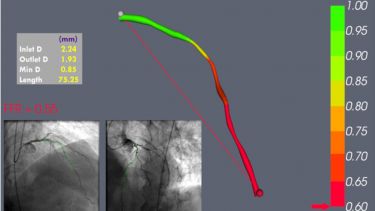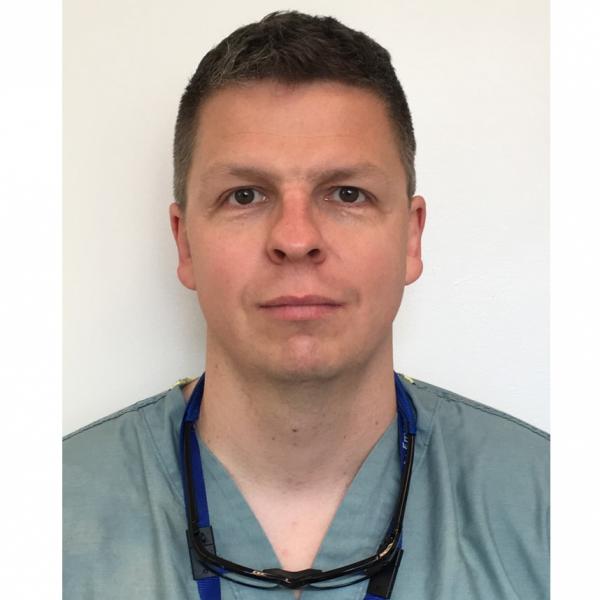Computational Modelling
Our research in computational modelling focuses on the following main topics; clinical decision support, improved understanding of (patho)physiology and novel computational techniques.

Clinical decision support
Clinicians are starting to embrace computational models within the imaging modalities they use, such as CT and MRI. We have developed a system called VIRTUheart™ which takes invasive angiographic images, constructs a 3D model of the vessel, and applies computational fluid dynamics (CFD) to calculate the blood flow through diseased segments. This is the basis of much of our research on blood flow (using a ‘virtual’ fractional flow reserve, vFFR, approach) in patients with coronary artery disease. We seek to use this system to answer many relevant clinical questions, such as: Can we predict the results of stenting? What is the effect of limitation of flow in multi-vessel disease? Can we model the effects of treatment in patients’ everyday life? What about branches? And so on. The cover image above is of a coronary artery stenosis and the colour map denotes the calculated limitation of flow.
Valvular Heart Disease currently affects 2.5% of the population. It is overwhelmingly a disease of the elderly and as a consequence is on the rise. It is dominated by two conditions, Aortic Stenosis and Mitral Regurgitation, both of which are associated with significant morbidity and mortality, yet which pose a truly demanding challenge for treatment optimisation. The timing and nature of interventional treatment is crucial in valve disease, but it remains a major challenge in current clinical practice; in the EU more than 70,000 valves are replaced or repaired per year. Our work within the EurValve project supported the implementation and validation of a model-based decision support system (DSS) for aortic and mitral valve diseases that allows simulation, comparison and understanding of outcomes and risks of different treatment strategies. The underlying technology developed as part of EurValve has broad application to other cardiovascular diseases and is being further developed to support the coronary applications described above. These technologies include formal approaches to sensitivity analysis to account for uncertainty in clinical data acquisition and to provide confidence measures to assist clinical decision making.
Improved understanding of (patho-)physiology
Computational modelling approaches are also developed within the Medical Imaging workstream to address fundamental scientific questions around the physiology and patho-physiology of the cardiovascular system. These activities often involve the processing of imaging data in order to establish the local anatomy to accurately assess fluid dynamics effects and their interaction with the relevant biological systems. Applications include the response of endothelial cells to local variations in blood flow, particularly within stented arteries, and the role of venous valves in controlling blood flow, both in the valve region and as part of the overall contribution to venous return.
Novel computational techniques
The translation of computational modelling to support clinical decision making requires the development of novel techniques to address the demands of the clinical environment. These include the challenges of providing results from complex modelling frameworks within timescales appropriate for delivery within current clinical workflows. The Medical Imaging workstream addresses these challenges through the development and application of approaches spanning reduced-order modelling, data assimilation and Artificial Intelligence (machine learning) techniques.
People, Projects & Publications
- People
- Current Projects / Grants
-
- How will virtual (computed) fractional flow reserve (vFFR) impact the management of coronary artery disease? VIRTU-4
- A comparison of virtual FFR software in the coronary circulation
- Towards a complete virtual (computed) model of myocardial ischaemia. VIRTU 5
- Sano Centre for Computational Personalised Medicine
- CompBioMed2 : A Centre of Excellence in Computational Biomedicine
- Wellcome Digital Innovator Award: Developing a machine learning tool to improve prognostic and treatment response assessment on cardiac MRI data
- NIHR AI award: Interactively trained ‘human-in-the-loop’ deep learning approach to improve cardiac CT and MRI assessment for accurate therapy response and mortality prediction
- Recent publications
-
- Swift AJ, Lu H, Uthoff J, Garg P, Cogliano M, Taylor J, Metherall P, Zhou S,Johns CS, Alabed S, Condliffe RA, Lawrie A, Wild JM, Kiely DG (2021) A machine learning cardiac magnetic resonance approach to extract disease features and automate pulmonary arterial hypertension diagnosis. European Heart Journal - Cardiovascular Imaging, 22(2), 236–245
- Morris PD, Gosling R, Zwierzak I, Evans H, Aubiniere-Robb L, Czechowicz K, Evans PC, Hose DR, Lawford PV, Narracott A, Gunn JP (2021). A novel method for measuring absolute coronary blood flow and microvascular resistance in patients with ischaemic heart disease. Cardiovascular Research, 117(6), 1567–1577
- Morris P, Gosling R, Rothman A, Iqbal J, Chiastra C, Colombo M, Migliavacca F, Banning A, Gunn J (2020) Double-kissing nanocrush for bifurcation lesions: development, bioengineering, fluid dynamics, and initial clinical testing. Canadian Journal of Cardiology, 36(6), 852-859
- Ferrari S, Ambrogio S, Narracott, AJ, Walker A, Morris PD, Fenner, JW (2021) An Encounter With Lattice Boltzmann for Biomedical Applications: Interactive Simulation to Support Clinical and Design Decisions. Journal of Engineering and Science in Medical Diagnostics and Therapy, 4(3), 031002
- Alexander Y, Osto E, Schmidt-Trucksäss A, Shechter M, Trifunovic D, Duncker DJ, Aboyans V, Bäck M, Badimon L, Cosentino F, De Carlo M, Dorobantu M, Harrison DG, Guzik TJ, Hoefer I, Morris PD, Norata GD, Suades R, Taddei S, Vilahur G, Waltenberger J, Weber C, Wilkinson F, Bochaton-Piallat ML, Evans PC (2020) Endothelial function in cardiovascular medicine: a consensus paper of the European Society of Cardiology Working Groups on Atherosclerosis and Vascular Biology, Aorta and Peripheral Vascular Diseases, Coronary Pathophysiology and Microcirculation, and Thrombosis. Cardiovascular Research, 117(1), 29-42
- Gabara L, Hinton J, Gunn J, Morris P, Curzen N (2020) Coronary Physiology Derived from Invasive Angiography: Will it be a Game Changer? Interventional Cardiology Review, 15:e06
- Gosling R, Sturdy J, Morris P, Fossan F, Hellevik L, Lawford P, Hose R, Gunn J (2020) Effect of side branch flow upon physiological indices in coronary artery disease. Journal of Biomechanics, 103, 109698
- Morris P, Curzen N, Gunn J (2020) Angiography‐Derived Fractional Flow Reserve: More or Less Physiology? Journal of the American Heart Association, 9, e015586
- Elhawaz A, Archer G, Zafar H, Fidock B, Barker N, Jones R, Rothman A, Hose R, Al-Mohammad A, Briffa N, Hunter S, Braidley P, Hall I, Grech E, van der Geest R, Gunn J, Swift A, Wild J, Garg P (2020) Left ventricular blood flow kinetic energy is associated with the six-minute walk test and left ventricular remodelling post valvular intervention in aortic stenosis. Quantitative Imaging in Medicine and Surgery, 11(4)
- Mercuri M, Wustmann K, von Tengg-Kobligk H, Göksu C, Hose DR, Narracott A (2020) Subject-specific simulation for non-invasive assessment of aortic coarctation: Towards a translational approach. Medical Engineering & Physics, 77, 69-79
- Whitfield AJ, Solanki R, Johns CS, Kiely D, Wild J, Swift AJ (2020) MRI Prediction of Precapillary Pulmonary Hypertension according to the Sixth World Symposium on Pulmonary Hypertension. Radiology, 294(2), 482
- Zun PS, Narracott AJ, Evans PC, van Rooij BJM, Hoekstra AG (2020) A particle-based model for endothelial cell migration under flow conditions. Biomechanics and Modeling in Mechanobiology,19, 681-692
- Johns CS, Kiely DG, Rajaram S, Hill C, Thomas S, Karunasaagarar K, Garg P, Hamilton N, Solanki R, Capener DA, Elliot C, Sabroe I, Charalamopopoulos A, Condliffe R, Wild JM, Swift AJ (2019) Diagnosis of Pulmonary Hypertension with Cardiac MRI: Derivation and Validation of Regression Models. Radiology, 290(1), 61-68
- Gosling R, Morris P, Silva D, Lawford P, Hose R, Gunn J (2019) Virtual Coronary Intervention: A Treatment Planning Tool Based Upon the Angiogram. JACC: Cardiovascular Imaging, 12(5), 865-872
- Gunn J, Taggart DP (2019) Transcatheter versus surgical intervention: lessons from trials of coronary revascularisation. Heart, 105(Suppl 2), s44-s49
- Sciola M, Morris P, Gosling R, Lawford P, Hose R, Gunn J (2018) The impact of Objective Mathematical Analysis during Fractional Flow Reserve measurement: results from the OMA-FFR study. EuroIntervention, 14, 935-941
- Gosling R, Morris P, Lawford P, Hose D, Gunn J (2019) Personalised fractional flow reserve: a novel concept to optimise myocardial revascularisation. EuroIntervention, 15(8), 707-713
- Morris P, Iqbal J, Chiastra C, Migliavacca F, Gunn J (2018) Simultaneous kissing stents to treat unprotected left main stem coronary artery bifurcation disease; stent expansion, vessel injury, hemodynamics, tissue healing, restenosis, and repeat revascularization. Catheterization & Cardiovascular Interventions, 92(6), E381-E392
- Gosling R, Morris P, Silva D, Lawford P, Hose R, Gunn J (2018) Predictive Physiological Modeling of Percutaneous Coronary Intervention – Is Virtual Treatment Planning the Future? Frontiers in Physiology, 9, 1107
- Mandaltsi A, Grytsan A, Odudu A, Kądziela J, Witowski A, Morris PD, Ellam T, Kalra P, Marzo A (2018) Non-invasive Stenotic Renal Artery Haemodynamics by in silico Medicine. Frontiers in Physiology, 17, 1106
- Zun PS, Narracott AJ, Chiastra C, Gunn J, Hoekstra AG (2019) Location-Specific Comparison Between a 3D In-Stent Restenosis Model and Micro-CT and Histology Data from Porcine In Vivo Experiments. Cardiovascular Engineering and Technology, 10, 568–582










